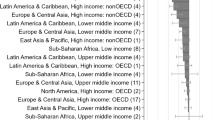Abstract
Tax and expenditure limits or TELs are constitutional or statutory constraints on the fiscal powers of government. Since the taxpayer revolt beginning in the late 1970s, TELs have been introduced in twenty-three states. In recent years a number of studies attempting to test the impact of TELs have found little evidence that TELs significantly reduced the growth of state government. In this study we challenge the implicit Leviathan model that underlies most of these studies, and offer an alternative rent-seeking model. Econometric tests provide support for this rentseeking model, and indicate that TELs have been significant in reducing the growth of state government, at least in the short run.
“... the very principle of constitutional government requires it to be assumed, that political power will be abused to promote the particular purpose of the holder; not because it always is so, but because such is the natural tendency of things, to guard against which is the especial use of free institutions”
Similar content being viewed by others
References
Abrams, B.A. and Dougan, W.R. (1986). The effects of constitutional restraints on governmental spending.Public Choice 49 (2): 101–116.
Advisory Commission on Intergovernmental Relations (1987).Fiscal discipline in the federal system: National reform and the experience of the states. Washington DC.
Bails, D. (1982). A critique of the effectiveness of tax expenditure limitations.Public Choice 38 (2): 129–138.
Becker, G.S. (1983). A theory of competition among pressure groups for political influence.The Quarterly Journal of Economics 98 (3): 371–400.
Bennet, J.T. and Dilorenzo, T.J. (1983).Underground government: The off-budget public sector. Washington, DC: The Cato Institute.
Benson, B.L. (1984). Rent-seeking from a property rights perspective.Southern Economic Journal 51 (October): 388–400.
Brennan, G. and Buchanan, J.M. (1980).The power to tax: Analytical foundations of a fiscal constitution. Cambridge: Cambridge University Press.
Box, G. and Jenkins, G. (1970).Time series analysis. San Francisco: Holden Day.
Buchanan, J.M. (1991).Constitutional economics. Oxford: Basil Blackwell.
Buchanan, J.M. and Vanberg, V.J. (1988). The politicization of market failure.Public Choice 57 (2): 101–113.
Buchanan, J.M. and Wagner, R. (1977).Democracy in deficit. New York: Academic Press.
Burton, J. (1987). Privatization: The Thatcher case.Managerial and Decision Economics 8: 21–29.
Chicoine, D.L. and Walzer, N. (1986). Factors affecting property tax reliance: Additional evidence.Public Choice 49 (1): 17–28.
Crain, M.W. and Tollison, R.D. (1990).Predicting politics: Essays in empirical public choice. Ann Arbor: The University of Michigan Press.
Flowers, M.R. (1977). Multiple tax sources, voting equilibrium, and budget size.Public Finance 32 (2): 210–224.
Hettich, W. and Winer, S. (1984). A positive model of tax structure.Journal of Public Economics 24: 67–87.
Higgs, R. (1987).Crises and Leviathan: Critical episodes in the growth of American government. New York: Oxford University Press.
Howard, M.A. (1989). State tax and expenditure limitations: There is no story.Public Budgeting and Finance (Summer): 83–90.
Joyce, P. and Mullins, D. (1991). The changing fiscal structure of the state and local public sector: The impact of tax and expenditure limitations.Public Administration Review 51 (3): 240–252.
Kalt, J.P. and Zupan, M.A. (1984). Capture and ideology in the economic theory of politics.American Economic Review 74 (3): 272–300.
McCormick, R.E. and Tollison, R.D. (1981).Politicians, legislation, and the economy: An inquiry into the interest-group theory of government. Boston: Martinus Nijhof.
Mill, J.S. (1861).Considerations on representative government. In J.S. Mill,Essays on politics and society, Vol. II. Toronto: University of Toronto Press, 1977.
Nelson, M.A. (1986). An empirical analysis of state and local tax structure in the context of the Leviathan model of government.Public Choice 49 (3): 283–294.
Olson, M. (1982).The rise and decline of nations: Economic growth, stagflation and social rigidities. New Haven: Yale University Press.
Pasour, E.C. (1985). The public interest and rent-seeking.Public Choice 47 (3): 527–529.
Peacock, A.T. and Wiseman, J. (1961).The growth of public expenditure in the United Kingdom. London: Allen and Unwin.
Poulson, B.W. (1992). Designing a state fiscal constitution. In American Legislative Exchange Council,Saving the States, 38–59. Washington, DC.
Poulson, B.W. and Vern, B. (1992).Competing visions of tax limitation for 1992: A policy maker's guide and economists backgrounder by associates of the independence institute. Golden Colorado: The Independence Institute.
Rowley, C.K., Shughart II, W.F. and Tollison, R.D. (1986). Interest groups and deficits. In J. Buchanan, C.K. Rowley and R.D. Tollison (Eds.),Deficits, 263–281. Oxford: Basil Blackwell.
Sjoquist, D.L. (1981). A median voter analysis of variations in the use of property taxes among local governments.Public Choice 36 (2): 273–285.
Spindler, Z.A. (1990). A rent-seeking perspective on privatization.North American Review of Economics and Finance 1: 87–105.
Spindler, Z.A. and Walker, M.A. (1988). Canadian tax reform as public choice.Contemporary Policy Issues 6 (4): 70–84.
Tollison, R.D. and Wagner, R. (1987). Balanced budgets and beyond. In J. Buchanan, C.K. Rowley and R.D. Tollison (Eds.),Deficits. Oxford: Basil Blackwell.
Tullock, G. (1967). The welfare costs of tariffs, monopolies, and theft.Western Economic Journal 5: 224–232.
Tullock, G. (1984). A partial rehabilitation of the public interest theory.Public Choice 42 (1): 89–99.
Tullock, G. (1987). Rents, ignorance and ideology. InThe Economics of special privilege and rent-seeking. Boston: Kluwer Academic Publishers.
Author information
Authors and Affiliations
Rights and permissions
About this article
Cite this article
Poulson, B.W., Kaplan, J. A rent-seeking model of TELs. Public Choice 79, 117–134 (1994). https://doi.org/10.1007/BF01047922
Accepted:
Issue Date:
DOI: https://doi.org/10.1007/BF01047922




